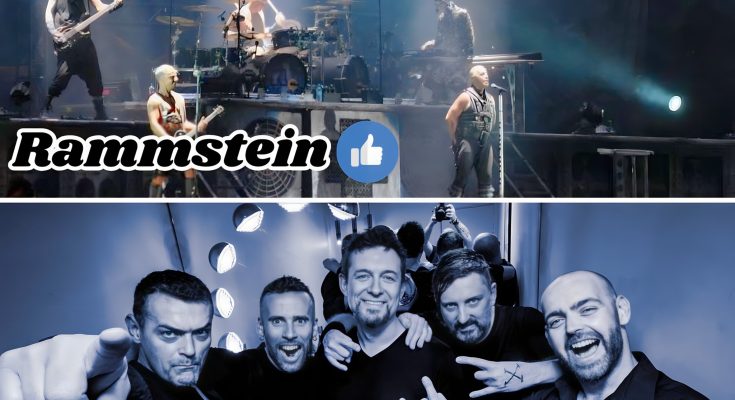Rammstein’s music stands as a towering example of industrial metal that is as grandiose as it is intense. Their sound is instantly recognizable, dominated by powerful rhythms that drive every track with an unyielding force. What makes Rammstein unique is their ability to fuse heavy metal’s raw aggression with the mechanical, often harsh elements of industrial music. The result is a sonic experience that is both dramatic and larger-than-life. Their songs frequently feature pounding drums, deep, chugging guitar riffs, and the commanding, almost theatrical vocals of Till Lindemann, whose baritone voice adds a layer of dark grandeur and emotional weight. The band’s German lyrics further enhance the gravity and atmosphere of their music, lending it a sense of mystique and cultural depth that transcends linguistic boundaries.
Rammstein’s compositions are meticulously crafted to create an atmosphere that is simultaneously powerful and cinematic. The driving rhythm section acts almost like a machine, precise and relentless, while the guitars add a metallic edge that can range from grinding to melodic. Synthesizers and electronic effects are layered throughout, adding texture and reinforcing the industrial feel. This blending of synthetic and organic sounds is one of the hallmarks of their style, creating a tension between cold mechanization and raw human energy. The music often feels like a soundtrack to a dystopian industrial landscape, evoking images of factories, machinery, and a dark, futuristic world.
One of the most striking aspects of Rammstein’s music is their use of dynamics. They are masters of contrast, shifting from crushing heaviness to eerie quietness and back again. This dynamic range enhances the theatricality of their songs, making each track feel like a dramatic narrative rather than just a collection of riffs and beats. Their live performances amplify this effect, with elaborate pyrotechnics, dramatic lighting, and choreographed stage antics that complement the music’s intensity. The visual spectacle becomes inseparable from the auditory experience, making Rammstein not just a band but a complete artistic phenomenon.
In comparison, Pitchshifter approaches industrial metal with a different sensibility, blending their sound with elements of electronic music, nu-metal, and bold experimental touches. Originating from the UK, Pitchshifter’s sound is marked by a willingness to push boundaries and fuse genres in innovative ways. While Rammstein emphasizes grandiosity and drama, Pitchshifter leans toward a more aggressive, kinetic energy infused with electronic influences. Their music often incorporates breakbeats, distorted vocals, and samples, creating a soundscape that is dense, layered, and at times chaotic. This fusion results in a hybrid style that is harder to categorize, drawing equally from metal’s intensity and electronic music’s flexibility.
Pitchshifter’s experimentation is evident in their use of technology as a core part of their music rather than just an accessory. They integrate drum machines, synthesizers, and sampling alongside traditional rock instrumentation, often manipulating sounds to create textures that feel both futuristic and abrasive. Their approach to songwriting tends to favor groove and rhythm, with an emphasis on creating an immersive sonic experience that engages the listener physically as well as intellectually. Unlike Rammstein’s theatrical and often anthemic approach, Pitchshifter’s music is more about atmosphere and sonic exploration, often feeling raw and underground while still maintaining a high level of technical skill.
Vocally, Pitchshifter’s delivery varies significantly from Rammstein’s deep, commanding baritone. Lead vocalist J.S. Clayden alternates between aggressive shouting, melodic singing, and distorted vocal effects, which adds to the experimental and unpredictable nature of their sound. This variety in vocal style mirrors the band’s genre-blending tendencies and allows them to express a wide range of emotions, from anger and defiance to introspection and melancholy. Their lyrics often tackle themes of technology, social issues, and personal struggle, reflecting a contemporary and sometimes dystopian worldview that aligns with the industrial aesthetic.
Both bands share a fascination with the mechanical and the industrial, but their expressions of this fascination diverge. Rammstein presents the industrial world as something imposing and monumental, a force that shapes human existence with both brutality and beauty. Their music reflects a kind of mythic vision of industry and power, imbued with symbolism and theatrical storytelling. Pitchshifter, meanwhile, portrays the industrial and technological world as fragmented, chaotic, and sometimes alienating. Their sound captures the tension and anxiety of living in a hyper-connected, media-saturated environment, using electronic and metal elements to create a sense of urgency and unrest.
The contrast between the two bands extends to their production styles as well. Rammstein’s albums are often polished and meticulously produced, with a clarity and weight that gives each instrument its own space while still maintaining a dense, powerful mix. The production supports their grandiose vision, enhancing the epic scale of their music. Pitchshifter’s production, on the other hand, is deliberately more abrasive and experimental. Their mixes can be dense and cluttered in a way that serves to emphasize the chaos and complexity of their sound rather than smooth it over. This approach reinforces their underground, alternative identity and their commitment to pushing the boundaries of genre and sound design.
Despite their differences, both bands have made significant contributions to the industrial metal genre by expanding its possibilities and introducing new elements. Rammstein brought industrial metal to a global audience with their distinctive German-language songs and theatrical performances, influencing countless bands and earning a dedicated fanbase worldwide. Their ability to balance heaviness with melody, and aggression with art, has cemented their place as icons of the genre. Pitchshifter, while perhaps less commercially known, have been equally influential within the alternative and experimental metal scenes. Their blending of electronic music and metal helped pave the way for later acts in the nu-metal and industrial-electronic crossover genres, inspiring artists who seek to merge technology and metal in innovative ways.
In terms of lyrical themes, Rammstein often explores dark and provocative subjects, including taboo topics, historical references, and critiques of society, all delivered with a mix of irony and seriousness. Their lyrics add depth to their music, inviting listeners to look beyond the surface and engage with the complexities of their storytelling. Pitchshifter’s lyrics tend to be more abstract and fragmented, matching their sonic experimentation. They reflect the anxieties of modern life, focusing on alienation, control, and resistance. Both bands use their lyrics to create mood and meaning, but while Rammstein’s are more narrative and theatrical, Pitchshifter’s are often cryptic and atmospheric.
Another point of divergence is the cultural context from which each band emerged. Rammstein formed in the aftermath of German reunification, a period of intense social and political change. Their music, language, and imagery draw heavily from German culture, history, and industrial heritage, creating a unique identity that blends pride with critique. This cultural grounding gives their music a particular resonance and authenticity that resonates deeply with fans both within and outside Germany. Pitchshifter emerged from the UK’s vibrant underground music scene, influenced by punk, electronic dance music, and the burgeoning alternative metal movement. Their music reflects a more globalized and hybridized cultural moment, where boundaries between genres and styles were increasingly blurred.
The live performances of both bands also highlight their differing artistic visions. Rammstein’s concerts are renowned for their theatricality, featuring elaborate stage setups, pyrotechnics, and choreographed movements that transform each show into a multimedia spectacle. This emphasis on performance art adds another layer to their music, making their live shows immersive and unforgettable experiences. Pitchshifter’s live shows, while energetic and intense, tend to focus more on the raw power of the music and the interaction with the audience rather than on elaborate staging. Their performances emphasize the underground, rebellious spirit of their music, often conveying a sense of immediacy and urgency.
In summary, Rammstein and Pitchshifter both occupy important spaces within the industrial metal genre, yet they approach their craft from very different angles. Rammstein’s grandiose, dramatic style is characterized by powerful rhythms, theatrical vocals, and a cinematic quality that elevates industrial metal to an art form. Their music is both monumental and accessible, balancing heaviness with melody and seriousness with irony. Pitchshifter’s approach is bolder in its experimentation, blending industrial, electronic, and nu-metal elements to create a sound that is complex, abrasive, and kinetic. Their willingness to push boundaries and incorporate technology as an integral part of their music sets them apart as pioneers within the genre’s more experimental wing.
Both bands showcase the diversity and richness of industrial metal, proving that the genre can encompass a wide range of sounds, themes, and artistic visions. Whether through Rammstein’s epic storytelling and powerful rhythms or Pitchshifter’s electronic-infused aggression and experimental textures, they have expanded the possibilities of what industrial metal can be. Their music reflects not only the mechanical and industrial world they draw inspiration from but also the human emotions and cultural contexts that shape their art. In doing so, Rammstein and Pitchshifter have left indelible marks on the landscape of modern metal and continue to influence new generations of musicians and fans alike.



